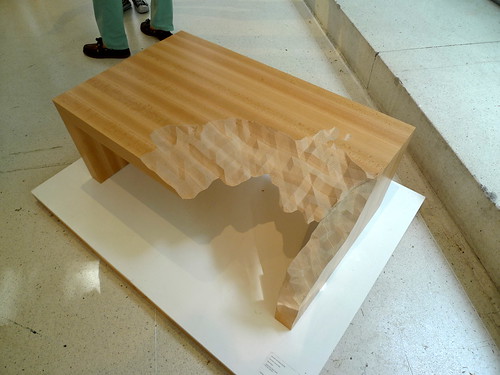by Suzanne Harb
‘Under the Influence’ by Manifold
04.07-11.08.2013

The Siobhan Davies Studios and 60|40 have teamed up for the fifth year running to allow the chance for artists to respond to this unique space while re-examining their own crafts. This final installment in the crafts collective’s Starting Point series sees Manifold, a group of 9 artists and designers, utilise this unique space over a 3-month residency.
Manifold is a diverse group who set up their studio in 2010 after graduation from The Royal College of Arts. Their individual activities include sculpture, drawing, digital art, textiles and hand modeling to name a few. Although diverse in their approach they are united in their need to portray processes, to their surroundings and progressive approaches to age-old ways of making.
As I approached the façade of the Siobhan Davies Studios I walked faster in anticipation of discovering the full charm of this converted school building from the late 1800’s. I had read about it but I was eager to see for myself the finished product of the work of Davies and architect Sarah Wigglesworth and the structure that would provide inspiration for the 9 artists in question. I was met with a clean, modern interior. The stairs placed outside the building, suspended from steel cords leading you up to the main studio on the top floor. A vast magnificent space tucked into London’s skyline with its warm wooden walls and sprung floors unique ceiling. However it is not this abundant space that these objects of in inspiration inhabit, but the meandering staircase and the short corridors filled with natural light. It is an intimate way of displaying the intimate objects that that make up the first part of this residency, moving in and out of the main body of the building as we view inside the artist’s mind. It is during this primary stage that the artists have taken to approaching this residency in a unique way and have decided to display the things that have influenced them and their artistic careers.
The displays are diverse and unique to each artist. The displays encompass personal photo albums and patchwork quilts to works from notable artists such as Gary Hume and illustrations by Quentin Blake. They wanted to utilise the residency to facilitate a truer response and to share something very personal.
When talking to Bethan Lloyd Worthington, she stated that as a group they decided quite early on that they wanted their time here to display a process. She said ‘we simply wanted to start at the beginning’, this meant the beginnings of their careers, even though they may not have known it at the time. A look into those people or objects that have gone on to inform their work and the work that they will produce here at The Siobhan Davies Studios.

Worthington's personal offerings
Among Lloyd Worthington’s offerings is Maisie Broadhead’s ‘Made in Britton’ (2011) is as Lloyd Worthington states ‘I think it encapsulates much of what we want to say with the show as a whole.’ A photograph of a member of Broadhead’s family, holding an earthenware jug from Bernard Leach’s course collection and surrounded by some of her own works. It is this layered meaning and influenced from a number of sources that is indicative of what Manifold is striving to convey. Another of Bethan’s contributions is a personal photograph of her Grandfather, a lay preacher, historian and teacher. It was taken at home once owned by the family highlighting her interest in sense of place and location.

Kim's taster of what is to come
Sue Ae Kim, a member of Manifold who has worked with ceramics has, on this occasion decided to explore the use of porcelain as a mode to respond to the context of the gallery. Her display at Under the Influence comprises of postcards depicting decorative porcelain figurines by Joseph Willems from the V&A. Ae Kim said that she had been looking a lot at the work of Willems as the detailed figurines and the use of porcelain itself would be an appropriate way to relate to the strong background of dance that the gallery is famous for. She also displays books relating to Willems influence, Meissen porcelain. Ae Kim also mentioned that she was also taking dance classes at the studios, taking this time to draw and dance, I can’t wait to see what the culmination of this processes will be later on in the year. It is this overt reference to influence, context and process (that in this case is cross cultural and cross generational) that really sums up what the group’s ethos and what they are trying to do here.
This interesting and fresh take on a residency and the portrayal of process in a highly personal manner is what makes Under the Influence so special. I loved this introduction to the group and the way in which it can lead the viewer to assess their own influences, sentimentality and achievements. The group didn’t want to simply create a site specific art work they have instead created a respective insight into the their crafts. I look forward to what Unfold (6 – 22 September) will have to offer.




